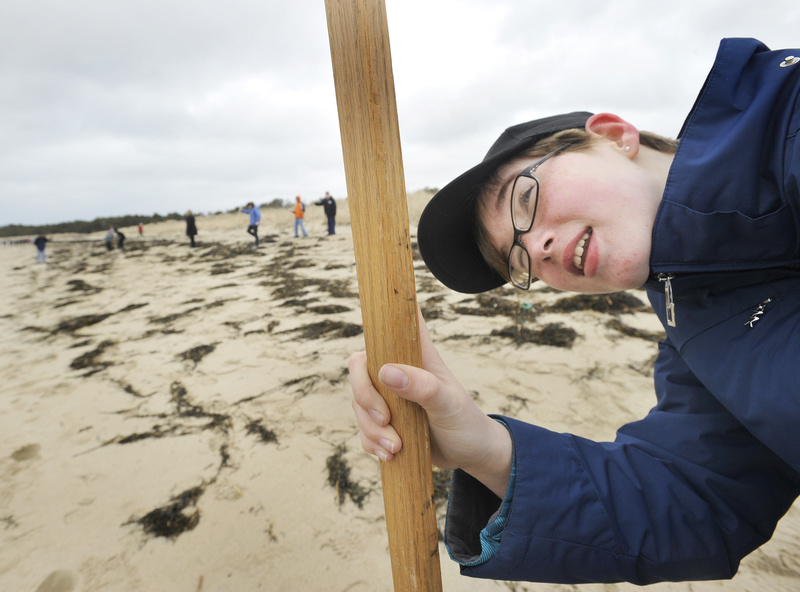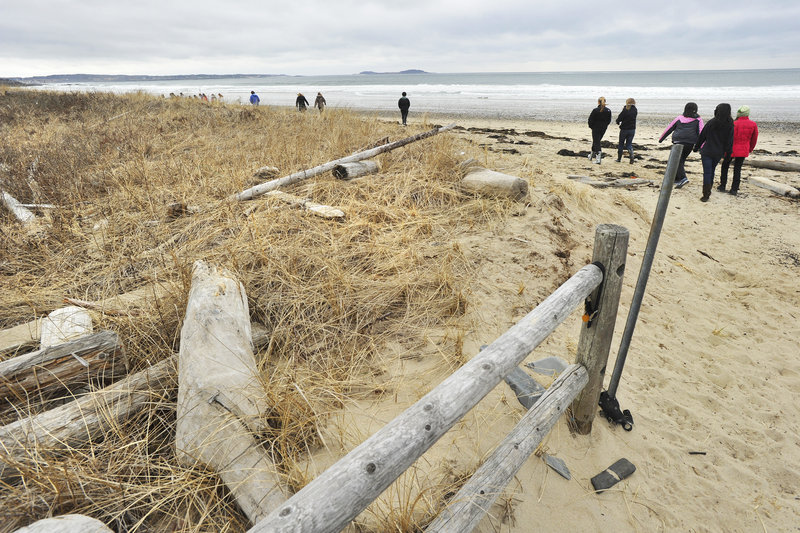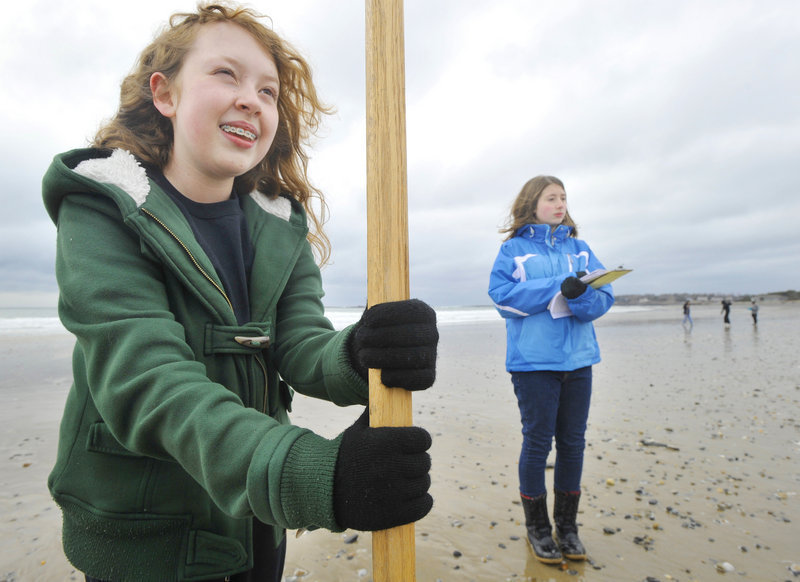SCARBOROUGH – Snow flurries and unrelenting winds made measuring the breadth and slope of the sand at Scarborough Beach more than a little uncomfortable on Thursday morning.
Teams of seventh-graders from Scarborough Middle School worked with sticks, strings and frozen fingers to chart the shoreline on their monthly field trip for the Southern Maine Beach Profile Monitoring Project.
The frigid temperatures were nothing compared to the waist-deep snow that challenged the students when they visited the beach in January.
“That was crazy,” Lydia Libby recalled during the quarter-mile trek from Black Point Road to the beach. “We were freezing and we could barely walk, but we did it.”
For a decade, Jim Doane’s seventh-grade science classes have been monitoring the beach for a statewide program coordinated by the Maine Sea Grant, the University of Maine Cooperative Extension Service and the Maine Geological Survey.
Since 1999, the survey has been cataloging and analyzing data on beach erosion and growth gathered by volunteers across Maine. It uses the information to help communities address coastal management issues.
The Scarborough students are among the youngest volunteers for the southern Maine project, said Jacob Aman, volunteer coordinator for the project. Aman was at the beach Thursday, making sure the students followed the scientific methods he had shown them during training sessions last fall.
“Most of our volunteers are retirees,” Aman said. “Obviously, we have to trust our volunteers to a certain extent. Sure, some of the students goof around out here, but most of them take it very seriously. The work they’re doing is very important.”
Doane, who works as a lifeguard at the beach in the summer, introduced his students to the beach-profiling project after he attended a professional development seminar on the benefits of authentic learning experiences. The beach project fills that role in a variety of ways beyond the obvious hands-on, environmental science lessons.
For one thing, visiting the beach when swimmers and sunbathers are absent shows the students an aspect of their community that few of them would see otherwise.
“Right now, you’re looking at a winter beach,” Doane said. “It’s all cobbles. Much of the sand that usually covers these stones is gone. (The students will) come here in the summer and the stones will be covered again because the sand migrates back.”
Doane said the mile-long beach appears to be eroding slowly because its sand was deposited by a glacier thousands of years ago and it doesn’t have a regular source of replenishment, such as a river carrying sediment.
Throughout the year, the students work on side projects related to their beach profiling excursions, becoming public relations specialists, field trip medics, dune experts, wildlife advocates and the like. They also learn something about teamwork, commitment and civic involvement.
Colby Thompson, Erin Whitney and Stephen Blackie made up one of 15 teams that profiled the beach on Thursday.
Colby and Erin each held a 1.5-meter stick, connected by three meters of string. Starting in the dunes, they moved the gauge toward the water’s edge like an inch worm. Colby eyeballed the slope of the beach against the distant horizon and shouted the measurements. Stephen jotted the numbers on a clipboard.
“If one person’s not on task, the whole thing is messed up,” Colby said.
The students understand that they are among a larger group of caretakers who are working to preserve a precious natural resource.
“We’re really helping out with something important,” Erin said. “We’re not just reading some boring textbook in the classroom. We’re actually contributing to science.”
Staff Writer Kelley Bouchard can be contacted at 791-6328 or at:
kbouchard@pressherald.com
Send questions/comments to the editors.





Success. Please wait for the page to reload. If the page does not reload within 5 seconds, please refresh the page.
Enter your email and password to access comments.
Hi, to comment on stories you must . This profile is in addition to your subscription and website login.
Already have a commenting profile? .
Invalid username/password.
Please check your email to confirm and complete your registration.
Only subscribers are eligible to post comments. Please subscribe or login first for digital access. Here’s why.
Use the form below to reset your password. When you've submitted your account email, we will send an email with a reset code.